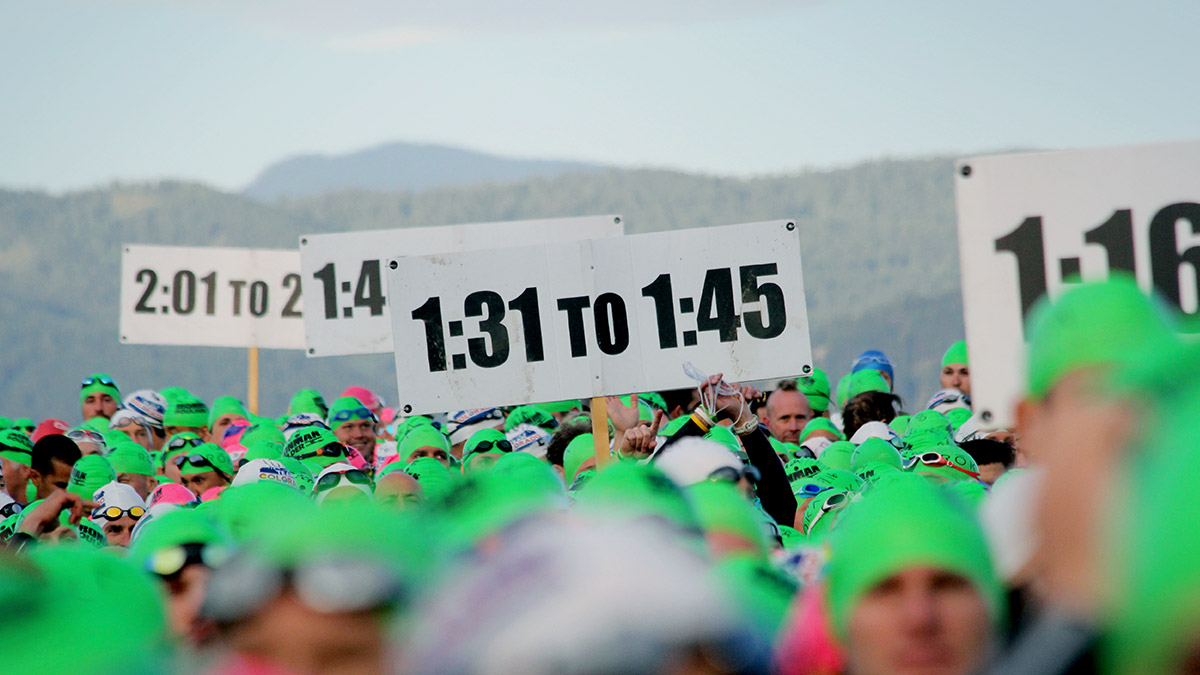It’s no secret that swim speed is highly dependent on technique and form — some coaches estimate that speed is 80% dependent on technique, with only 20% dependent on fitness. We know that swimming harder (i.e., with more effort) will often not translate into swimming faster until we get the technique piece right.
When analyzing an athlete’s swim form, I prioritize fixing anything that could lead to injury and then move onto components of form that will improve both speed and efficiency. This article will review the most common swim form mistakes and how you can fix them.
Swim Errors That May Cause Injury
Crossing Over
Crossing over occurs when a swimmer’s hand entry crosses the midline of the body (i.e., the hand enters the water in front of the head rather than directly in front of the shoulder). This is one of the most common mistakes in swim form, and can cause shoulder impingement and affect alignment by causing the opposite hip to splay out.
For optimal efficiency, you want your hand to stay away from your body’s centerline by keeping it in line with the shoulder. When you first correct this, it will most likely feel like you are entering really wide, though you’re probably not.
Crossing over can be very hard to feel, especially if you’ve been swimming like that for a long time — video yourself to properly diagnose whether you cross over.
How to fix it:
- Watch how your hand enters the water with a drill like “alligator eyes”, where you hold your goggles at the surface of the water while swimming freestyle.
- Use your shadow or a mirror at the bottom of the pool to watch your hand entry.
- Try the “catch-up drill” using a 12-inch dowel or a kickboard turned sideways to make sure your hands enter to the outside of the dowel or kickboard.
Wide Entry
Alternatively, entering too wide or sculling the hand out after entry is another issue which can cause shoulder impingement. You might be especially prone to this if you cross over and then over-correct, or if you were originally taught the “S-pull” freestyle.
How to fix it:
- To correct entering too wide, I recommend the “alligator eyes” drill.
- To correct sculling out after entry, I recommend the pinky first entry drill, where you’ll swim normal freestyle but enter the hand pinky first so it’s unable to scull outwards after entry.
Hand Entry
The last swimming error that I often see is entering index finger first during the hand entry, which can cause shoulder impingement over time. Instead, your hand should enter with a flat palm, not turned inward. This can also be corrected by the pinky first drill.
Swim Errors that Impede Speed and Efficiency
Body Position
First and foremost, you should make sure your hips and legs aren’t sinking. This happens when you lift your head before breathing or by holding your head too high during a stroke. Instead, your head should be held in a neutral position, with your gaze down towards the bottom of the pool.
How to fix it:
- A great drill to check head position is banding the legs together and swimming freestyle (with no kick and no pull buoy). If your legs sink, you are likely holding your head too high. This is a more advanced drill, but a great one.
- I also often see athletes not holding their head still while they swim by bobbing their head with each hand entry. A great video example to show athletes a perfect, quiet head position is Katie Ledecky holding a cup of chocolate milk on her head while swimming freestyle.
Breathing
Breathing can cause major swimming issues. Beginners, in particular, often turn their head too far and over-rotate to breathe, which can then affect their balance in the water, causing a scissor kick to correct.
How to fix it:
- Use the split vision breath during the front kick breath drill, where one goggle is in the water and one goggle is out while you kick with one arm extended in front and one arm at your side. Breathe with as little rotation as possible and come straight back down.
The Catch
Once alignment and balance issues are fixed, you can work to catch the water more effectively rather than “slipping through the water.” I often see swimmers bend their wrist too much so they are only using their hand to pull through. Maintaining a firm wrist and high elbow catch to engage the entire forearm in the pull will create the best surface area.
How to fix it:
- Try the fist drill by swimming normal freestyle but with closed fists so you’re forced to use your forearms to pull through the water.
- Use paddles with only the finger band (and no band on the wrist) so you’re forced to keep your hand beneath your elbow through the catch and pull instead of dropping your elbow.
- The YMCA drill is great for learning a proper high elbow catch.
- Practicing a high elbow catch with swim bands or on a Vasa trainer can help improve body awareness through the catch and pull.
Focus on One Thing at a Time
Learning to improve technique takes time. To maximize your improvements, keep your focus limited to just one or two components of form during each swim workout. Focusing on too many things at once can be overwhelming — and you won’t be able to perfect your corrections.
To diagnose where your efforts should be focused, get a video analysis or have a coach or fellow swimmer on deck to provide feedback. Both of these can be very helpful tools for feedback of your swim form progress.
Happy swimming — and remember to swim smarter, not harder!








